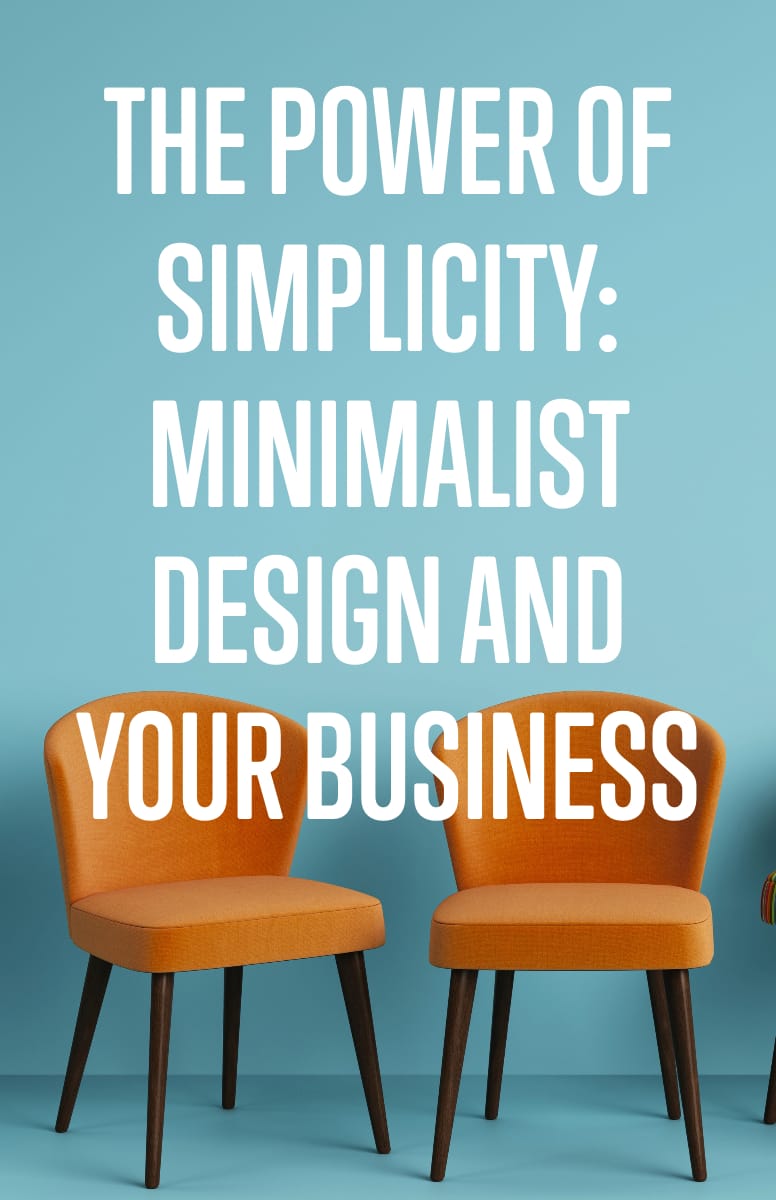
In an era where information overload is a common concern, the power of simplicity in web design has never been more crucial. Minimalist design, characterized by clean lines, thoughtful use of whitespace, and a focus on essential elements, offers an antidote to the noise and complexity of modern web pages. This post explores the core principles of minimalist design and its alignment with user experience, showcasing its benefits and providing a practical guide for implementation.
The Power of Simplicity: Minimalist Design and Your Business
Minimalist design, an aesthetic that focuses on essential content and functionality, offers a refreshing counterpoint to the overloaded visuals and features found in many contemporary websites.
Definition and principles of minimalist design
Minimalism in design is not about a lack of content or creativity; rather, it’s about a thoughtful reduction and focus on the essentials. It’s a design philosophy that seeks to communicate the core message with as few elements as possible. Key principles include:
- Simplicity: The use of clean lines, basic shapes, and a limited color palette.
- Functionality: Every element must have a purpose, enhancing user experience rather than distracting from it.
- Whitespace: Utilization of empty space to create focus and aid in navigation.
- Typography: Careful selection of fonts that align with the overall design, ensuring readability and visual harmony.
How minimalism aligns with modern user experience
Today’s users crave a seamless and intuitive online experience. Minimalist design meets these demands by:
- Enhancing Usability: By focusing on key tasks and reducing unnecessary elements, users can navigate the site more easily.
- Improving Accessibility: Simplicity in design often translates to better accessibility, making the website user-friendly for all.
- Aligning with Mobile Usage: Minimalist design naturally adapts to various screen sizes, essential in a mobile-first world.
The Benefits of Minimalism for Your Business
Embracing minimalist design is more than an aesthetic choice; it can offer tangible benefits that align with your business goals. Here’s how minimalism can positively impact your brand and your bottom line:
Enhancing user focus and attention
A minimalist design, free from unnecessary distractions, allows users to focus on what’s most important. Whether it’s a call-to-action button or a key piece of information, minimalism draws attention to the primary content. This strategic focus can increase engagement and conversion rates, driving business success.
Faster loading times and improved performance
Overly complex designs can slow down a website, leading to a negative user experience. By cutting the clutter, minimalist design often translates to faster loading times and smoother performance. This improved user experience can reduce bounce rates and enhance customer satisfaction, factors that are vital in today’s competitive online marketplace.
Building a sleek and professional brand image
Minimalism conveys an image of professionalism, sophistication, and modernity. By adopting a clean and concise design, you can align your website with these values, creating a cohesive and compelling brand image. This not only appeals to your target audience but also differentiates your business in a crowded market.
Key Elements of Minimalist Design
Whether you’re considering a complete redesign or simply looking to streamline your existing website, understanding the key elements of minimalist design is essential. Here’s what to keep in mind:
Utilizing whitespace effectively
Whitespace is not “empty” space but rather a powerful design tool. Effective use of whitespace creates balance, aids navigation, and emphasizes critical content. It allows the design to breathe, offering users a visually relaxing and intuitive experience.
Choosing the right color scheme and typography
Color and typography play crucial roles in minimalist design. A restrained color palette can create visual harmony, while thoughtful typography ensures legibility and reflects your brand personality. Both elements must be carefully chosen to support rather than overshadow your content.
Incorporating essential visual elements without clutter
Minimalism doesn’t mean devoid of visuals. It’s about using images, icons, or illustrations purposefully. Every visual element should enhance understanding or add aesthetic value without causing confusion or clutter.
The beauty of minimalist design lies in its adaptability and effectiveness across various industries and business sizes. By focusing on the essentials and eliminating the unnecessary, you can create a web presence that is not only aesthetically pleasing but also highly functional and aligned with your business objectives. The thoughtful implementation of minimalism can lead to a streamlined user experience and a stronger connection with your audience, contributing to your overall success.
How to Implement Minimalist Design in Your Website
Embracing the minimalist design philosophy for your business website requires thoughtful planning and execution. It’s not about simply removing elements but rather about creating a seamless, user-friendly experience that communicates your brand’s essence. Here’s a guide to help you get started:
A step-by-step guide to simplifying your website’s layout
- Identify Your Core Message: What are the key messages and actions you want your visitors to take? Define them clearly.
- Evaluate Existing Content: Remove or reorganize anything that doesn’t support your core objectives.
- Create a Visual Hierarchy: Use size, color, and placement to guide visitors’ eyes to the most important information.
- Incorporate Whitespace: Allow elements to breathe and facilitate a clear understanding of where one section ends and another begins.
- Test User Experience: Ensure that the simplified design supports usability and a positive user experience.
Strategies for content reduction and prioritization
- Identify Essential Content: Determine what content is absolutely necessary to convey your message or facilitate user goals.
- Use Visuals Wisely: Replace long texts with icons, images, or infographics where applicable, without losing context.
- Prioritize Information: Arrange content according to user needs and business goals to provide a streamlined experience.
Tips on collaborating with a design professional
- Share Your Vision: Provide clear insight into your brand, audience, and objectives to your designer.
- Ask for Their Expertise: Leverage your designer’s expertise in minimalist design principles to craft a site that aligns with your goals.
- Iterate and Review Together: Work closely with your designer through iterations and revisions to achieve the desired minimalistic aesthetics and functionality.
Analysis of real-life examples where minimalist design drove business success
- Apple: Known for its clean and simple design, Apple’s website reflects the brand’s focus on user-centric design and innovation.
- Airbnb: With a user-friendly layout, clear call-to-action, and limited color palette, Airbnb’s site emphasizes ease of use and inspires trust.
Common pitfalls and how to avoid them
- Over-Simplification: Avoid stripping away too many elements, leading to a loss of essential information or functionality.
- Lack of Contrast: Ensure that your text and essential elements stand out sufficiently against the background.
- Ignoring Responsiveness: Make sure your minimalist design translates well to different devices, maintaining usability and appearance.
How minimalist design adapts to different industries and markets
Different sectors can harness the power of minimalism to suit their specific needs:
- Retail Businesses: Use minimalism to highlight products and streamline the shopping process.
- Healthcare: A simple, calming design can enhance patient experience and make information easily accessible.
- Technology: For tech companies, a sleek design can emphasize innovation and efficiency.
In conclusion, implementing minimalist design in your website is not just a stylistic choice; it’s a strategic approach to improve user experience, boost performance, and align with your brand. By understanding and utilizing the principles of minimalism effectively, you can create a website that resonates with your audience and helps drive your business goals. Whether you choose to undertake this design journey alone or collaborate with a professional, the emphasis should always be on clarity, functionality, and alignment with your core values.
Ready to transform your website with a minimalist design that speaks to your brand’s essence? At Graticle Design, we specialize in crafting unique, clean, and user-centric designs that not only look beautiful but work seamlessly. Our team is dedicated to understanding your specific needs and delivering a tailored solution that will elevate your online presence. Let’s make your vision come to life and create a website that engages your audience, enhances user experience, and drives your business goals.
Contact us today to get started on your next project! (360) 450-3711
—
Frequently Asked Questions
Can minimalist design work even for complex websites with a lot of information? A1: Absolutely! Minimalist design doesn’t mean a lack of information; it’s about presenting information in a clear and uncluttered way. Even complex websites can benefit from minimalist principles by organizing content thoughtfully and focusing on essential elements.
Will a minimalist website design look too plain or boring for my audience? A2: Minimalist design doesn’t have to be plain or boring. By choosing the right color scheme, typography, and visual elements, you can create a website that’s elegant and engaging. The key is to find a balance that reflects your brand’s identity while maintaining simplicity.
How can I be sure that minimalist design aligns with my brand’s values and image? A3: Understanding your brand’s core values and target audience is essential in determining whether minimalist design is the right approach. Collaborating with experienced designers who can interpret your brand’s personality into a minimalist context can ensure that the design aligns with your brand’s image.
I have an existing website; can I transition to a minimalist design without a complete overhaul? A4: Transitioning to a minimalist design doesn’t necessarily require a complete overhaul. By working with professionals like Graticle Design, you can identify areas for simplification and refinement. It might involve decluttering the design, reorganizing content, and choosing simpler visual elements that still convey your message effectively.
Are there any specific industries or markets where minimalist design is particularly effective or popular? A5: Minimalist design has found success across various industries, from tech to fashion to hospitality. It’s particularly popular where a sleek, modern, and professional image is desired. However, its principles can be adapted and applied creatively to suit almost any industry or market.





